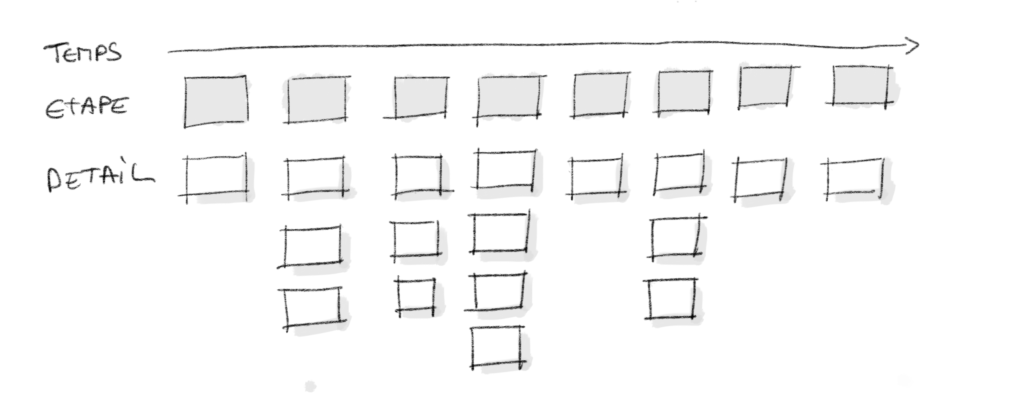Here is an animation review of the User Storymapping workshop, as proposed by Sophie FREIERMUTH, during FLUPA 2016.

As a preamble, it is recommended to have done user research to have a well-defined persona and a clear objective before starting a Storymapping workshop. The goal will either be to solve a user problem (90% of cases) or enchant the user by a product not necessarily useful, but captivating (for example, angry birds).
The aim of the workshop is to get out what is in the minds of the participants. It's not about explaining your idea, you have to, in a collaborative way, build the story – the journey.

4 key phrases make it possible to feed the narrative mechanics during the workshop:
- The story unfolds sequentially using “And then… to make the link between two sequences. We can also use “and then” by reformulating what the user said and ending with “and then?…” leaving a blank and thus pushing the interlocutor to move the story forward. This technique allows you to collect your point of view.
- "Because...” : allows you to go back in time in history by identifying the causes
- "Meanwhile…” allows you to branch off to another user
- "And if ?…” opens the door to possibilities.
The challenge of narrative tools: capturing the verbal to turn it into visual.
Once the theoretical presentation is over, we move on to practice with two workshops:
- Exercise 1: Story mapping the ritual of sleep – the transition from being awake and dressed to sleeping in bed.
- Exercise 2: storymap the first meeting of a fictional matchmaking application at trade shows.
Through the two exercises, we approach the round trip between global vision and detail and the question of cutting out spots/under spots. We notice a deposit visual: a stain that appears on several post-its is de facto shared by all the participants. The real objective of the workshop appears: extract and share knowledge between participants.
The UX designer must give up his function of participant to inhabit the function of moderator. In particular, he must ensure that:
- pass the passwords to each other,
- focus on production written in the form of post-its rather than the endless discussions
- encourage the back and forth between overview and details.
- consolidate the narrative frame to ensure that the user goal is achieved.

As the workshop progresses, we see that the story mapping will make it possible to have a first line devoted to the main stages, which will then be broken down into elementary tasks. We can then prioritize these tasks according to the user value. to a certain extent, the set of post-its on the wall represents the backlog, ie the set of functions to be performed to build the product.
In conclusion, we see that the benefits of the approach are multiple:
- promotes partage of knowledge between the participants
- encouragement round trip between the global vision / detail
- approach narrative et visual aligned with the user vision
UX/UI ECO-DESIGN # Paris
SMILE Paris
163 quay of Doctor Dervaux 92600 Asnières-sur-Seine
DESIGN THINKING: CREATING INNOVATION # Belgium
UX-REPUBLIC Belgium
12 avenue de Broqueville - 1150 Woluwe-Saint-Pierre
MANAGING AND MEASURING UX # Paris
SMILE Paris
163 quay of Doctor Dervaux 92600 Asnières-sur-Seine
DESIGN SPRINT: INITIATION & FACILITATION # Paris
SMILE Paris
163 quay of Doctor Dervaux 92600 Asnières-sur-Seine
UX-DESIGN: THE FUNDAMENTALS # Belgium
UX-REPUBLIC Belgium
12 avenue de Broqueville - 1150 Woluwe-Saint-Pierre
GOOGLE ANALYTICS 4 #Paris
SMILE Paris
163 quay of Doctor Dervaux 92600 Asnières-sur-Seine
ACCESSIBLE UX/UI DESIGN # Belgium
UX-REPUBLIC Belgium
12 avenue de Broqueville - 1150 Woluwe-Saint-Pierre
EXPERIENCE MAPPING # Paris
SMILE Paris
163 quay of Doctor Dervaux 92600 Asnières-sur-Seine












